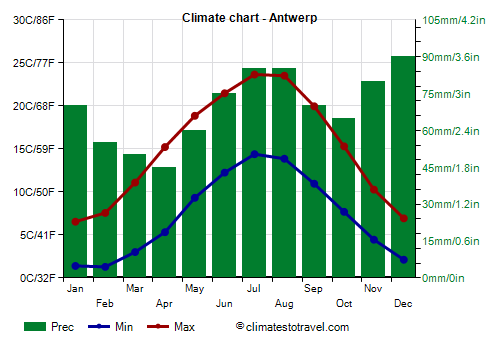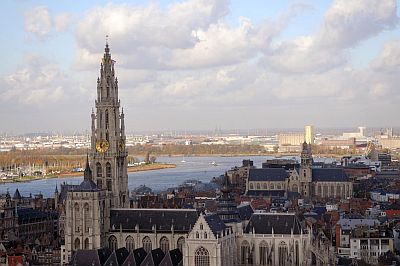Select units of measurement for the temperature and rainfall tables (metric or imperial).
Average weather, temperature, rainfall, sunshine hours

In Antwerp, a city located in the region of Flanders, in the north of Belgium, the climate is sub-oceanic, humid and rainy, influenced by the Atlantic Ocean: winters are cold but not freezing, while summers are mild or pleasantly warm.
The
wind blows frequently, and can be intense, especially from November to March.
Precipitation is relatively abundant, 825 millimeters (32.5 inches) per year, but above all, it is common and well distributed throughout the year. However, the rainiest seasons are summer and autumn, and the least rainy season is spring. Rainfall often occurs in the form of short showers or drizzle.
Antwerp does not get a lot of
sun, especially from November to February, when the sun rarely shines. It goes a bit better in spring and in summer, when the weather is variable, and between one disturbance and another, the sun can come out.
 Winter
Winter, from December to February, is cold: temperatures are on average around freezing (0 °C or 32 °F) at night and a few degrees above during the day; wind and humidity often exacerbate the feeling of cold.
However, different weather situations can occur.
When the westerlies blow, temperatures can be quite mild, and can reach 10/12 °C (50/54 °F), but there may be wind and rain.
On the other hand, when the city is affected by cold air masses from Russia, the temperature drops below freezing, for longer or shorter periods, even during the day. The temperature rarely drops below -10 °C (14 °F), however, it can do it in the coldest periods. The coldest record is -18.5 °C (-1.3 °F) and was set in January 1968.
During the "Little Ice Age" (1450-1850), the Scheldt, the river that crosses the city and flows into the sea just north of it, used to freeze quite often; today, this happens very rarely.
Snowfalls in Antwerp are quite frequent, though usually not abundant, and occur in the form of light snow, sometimes, however, snow can accumulate on the ground, and last for many days, if it occurs during cold waves.
 Spring
Spring, from March to May, is initially cold, with possible snowfalls still in March, and then it gradually becomes milder in April and May, although some cold days, with highs around 10 °C (50 °F), can occur still in May, especially in the first half of the month. However, April and May are, albeit slightly, the least rainy and cloudy months.
Typically, by the second half of May, the temperatures become permanently acceptable, and there can be the first pleasantly warm days, with highs around 25 °C (77 °F) or even above.
Summer, from June to August, is mild or pleasantly warm. The flow of Atlantic fronts does not cease even in this season. The wind blows constantly from the sea, and even rainfall is quite frequent.
However, there are pleasant periods when the daytime temperatures are between 20 °C and 25 °C (68 °F and 77 °F), but also cooler periods when they remain below 20 °C (68 °F). At night, it can be a bit cold, in fact, the temperature can drop below 10 °C (50 °F) even in July and August.
From time to time, there may be hot periods of short duration, in which the temperature can reach or exceed 30 °C (86 °F), which are becoming more frequent due to global warming. The highest record is 40 °C (104 °F), set during the short but exceptional heatwave of July 2019.
Autumn, from September to November, is initially pleasant, ie in the first half of September, then it gradually becomes more cold, dull, wet and windy. The first night frosts usually occur in November, but sometimes also in October.
Best Time
The
best time to visit Antwerp runs from mid-May to mid-September, since it is the mildest of the year. July and August are the warmest months. However, it's better to bring a sweatshirt or sweater, a light jacket and an umbrella, for cool and rainy days.
Antwerp - Climate data
In Antwerp, the
average temperature of the coldest month (January) is of
4 °C, that of the warmest month (July) is of
19 °C. Here are the average temperatures.
Antwerp - Average temperatures (1991-2020) |
| Month | Min | Max | Mean |
|---|
| January | 1.4 | 6.5 | 4 |
|---|
| February | 1.3 | 7.6 | 4.4 |
|---|
| March | 3 | 11.1 | 7 |
|---|
| April | 5.3 | 15.2 | 10.3 |
|---|
| May | 9.3 | 18.8 | 14.1 |
|---|
| June | 12.2 | 21.5 | 16.9 |
|---|
| July | 14.4 | 23.6 | 19 |
|---|
| August | 13.9 | 23.5 | 18.7 |
|---|
| September | 11 | 20 | 15.5 |
|---|
| October | 7.7 | 15.3 | 11.5 |
|---|
| November | 4.4 | 10.3 | 7.4 |
|---|
| December | 2.1 | 6.9 | 4.5 |
|---|
| Year | 7.2 | 15.1 | 11.1 |
|---|
amounts to
825 millimeters per year: so, it is at an intermediate level. It ranges from
45 millimeters in the driest month (April) to
90 millimeters in the wettest one (December). Here is the average precipitation.
Antwerp - Average precipitation| Month | Days |
|---|
| January | 70 | 12 |
|---|
| February | 55 | 11 |
|---|
| March | 50 | 10 |
|---|
| April | 45 | 9 |
|---|
| May | 60 | 10 |
|---|
| June | 75 | 10 |
|---|
| July | 85 | 10 |
|---|
| August | 85 | 10 |
|---|
| September | 70 | 9 |
|---|
| October | 65 | 10 |
|---|
| November | 80 | 12 |
|---|
| December | 90 | 13 |
|---|
| Year | 825 | 127 |
|---|
There are on average around 1630
sunshine hours per year. Here are the average hours of sunshine per day.
Antwerp - Sunshine hours| Month | Average | Total |
|---|
| January | 2 | 55 |
|---|
| February | 2.5 | 75 |
|---|
| March | 4 | 120 |
|---|
| April | 6 | 175 |
|---|
| May | 6.5 | 210 |
|---|
| June | 6.5 | 200 |
|---|
| July | 7 | 215 |
|---|
| August | 6.5 | 200 |
|---|
| September | 5 | 145 |
|---|
| October | 3.5 | 115 |
|---|
| November | 2 | 60 |
|---|
| December | 1.5 | 45 |
|---|
| Year | 4.5 | 1630 |
|---|
Antwerp - Weather by month
Based on the period 1991-2020
January, the coldest month of the year, is generally a quite cold month. The average temperature is of
4 °C, with a minimum of
1.4 °C and a maximum of
6.5 °C.

On the coldest nights of the month, the temperature usually drops to around
-7.5 °C. However, it dropped to
-14.9 °C in January 1997.

On the warmest days of the month, the temperature usually reaches around
13.5 °C. However, it reached
15.6 °C in January 2016.

Precipitation amounts to
70 mm, distributed over 12 days.
The day lasts on average 8 hours and 30 minutes.

There are on average 2 hours of sunshine per day. So, the sun shines 22% of the time.
The average humidity is 83%. Hence, the air is normally humid.
The average wind speed is of
14.6 kph.
February is generally a quite cold month. The average temperature is of
4.4 °C, with a minimum of
1.3 °C and a maximum of
7.6 °C.

On the coldest nights of the month, the temperature usually drops to around
-6.5 °C. However, it dropped to
-15.1 °C in February 2012.

On the warmest days of the month, the temperature usually reaches around
14 °C. However, it reached
19 °C in February 2019.

Precipitation amounts to
55 mm, distributed over 11 days.
The day lasts on average 10 hours and 0 minutes.

There are on average 2.5 hours of sunshine per day. So, the sun shines 27% of the time.
The average humidity is 80%. Hence, the air is normally humid.
The average wind speed is of
14 kph.
March is generally a quite mild month. The average temperature is of
7 °C, with a minimum of
3 °C and a maximum of
11.1 °C.

On the coldest nights of the month, the temperature usually drops to around
-3.5 °C. However, it dropped to
-10.8 °C in March 2013.

On the warmest days of the month, the temperature usually reaches around
18.5 °C. However, it reached
23 °C in March 2017.

Precipitation amounts to
50 mm, distributed over 10 days.
The day lasts on average 12 hours and 0 minutes.

There are on average 4 hours of sunshine per day. So, the sun shines 33% of the time.
The average humidity is 75%. Hence, the air is normally humid.
The average wind speed is of
13.7 kph.
April is generally a mild month. The average temperature is of
10.3 °C, with a minimum of
5.3 °C and a maximum of
15.2 °C.

On the coldest nights of the month, the temperature usually drops to around
-1 °C. However, it dropped to
-3.7 °C in April 1991.

On the warmest days of the month, the temperature usually reaches around
23.5 °C. However, it reached
28.7 °C in April 2018.

Precipitation amounts to
45 mm, distributed over 9 days.
The day lasts on average 13 hours and 55 minutes.

There are on average 6 hours of sunshine per day. So, the sun shines 42% of the time.
The average humidity is 69%.
The average wind speed is of
11.8 kph.
May is generally a mild month. The average temperature is of
14.1 °C, with a minimum of
9.3 °C and a maximum of
18.8 °C.

On the coldest nights of the month, the temperature usually drops to around
3 °C. However, it dropped to
-1.1 °C in May 1996.

On the warmest days of the month, the temperature usually reaches around
27.5 °C. However, it reached
33 °C in May 2005.

Precipitation amounts to
60 mm, distributed over 10 days.
The day lasts on average 15 hours and 35 minutes. So the days are long.

There are on average 6.5 hours of sunshine per day. So, the sun shines 43% of the time.
The average humidity is 69%.
The average wind speed is of
11.7 kph.
June is generally a very mild month. The average temperature is of
16.9 °C, with a minimum of
12.2 °C and a maximum of
21.5 °C.

On the coldest nights of the month, the temperature usually drops to around
6.5 °C. However, it dropped to
3.5 °C in June 2006.

On the warmest days of the month, the temperature usually reaches around
30 °C. However, it reached
34.4 °C in June 2005.

Precipitation amounts to
75 mm, distributed over 10 days.
The day lasts on average 16 hours and 30 minutes. So the days are long. June 21, the summer solstice, is the longest day of the year in the Northern Hemisphere.

There are on average 6.5 hours of sunshine per day. So, the sun shines 41% of the time.
The average humidity is 70%.
The average wind speed is of
11.5 kph.
July, the warmest month of the year, is generally a warm month. The average temperature is of
19 °C, with a minimum of
14.4 °C and a maximum of
23.6 °C.

On the coldest nights of the month, the temperature usually drops to around
9.5 °C. However, it dropped to
6.2 °C in July 2015.

On the warmest days of the month, the temperature usually reaches around
32 °C. However, it reached
40.2 °C in July 2019.

Precipitation amounts to
85 mm, distributed over 10 days.
The day lasts on average 16 hours and 0 minutes. So the days are long.

There are on average 7 hours of sunshine per day. So, the sun shines 43% of the time.
The average humidity is 70%. Hence, the air is normally humid.
The average wind speed is of
11.1 kph.
August is generally a warm month. The average temperature is of
18.7 °C, with a minimum of
13.9 °C and a maximum of
23.5 °C.

On the coldest nights of the month, the temperature usually drops to around
8.5 °C. However, it dropped to
4.9 °C in August 1993.

On the warmest days of the month, the temperature usually reaches around
31.5 °C. However, it reached
35.5 °C in August 2012.

Precipitation amounts to
85 mm, distributed over 10 days.
The day lasts on average 14 hours and 30 minutes. So the days are long.

There are on average 6.5 hours of sunshine per day. So, the sun shines 45% of the time.
The average humidity is 72%. Hence, the air is normally humid.
The average wind speed is of
10.4 kph.
September is generally a very mild month. The average temperature is of
15.5 °C, with a minimum of
11 °C and a maximum of
20 °C.

On the coldest nights of the month, the temperature usually drops to around
5.5 °C. However, it dropped to
1.1 °C in September 2018.

On the warmest days of the month, the temperature usually reaches around
26.5 °C. However, it reached
34.4 °C in September 2020.

Precipitation amounts to
70 mm, distributed over 9 days.
The day lasts on average 12 hours and 35 minutes.

There are on average 5 hours of sunshine per day. So, the sun shines 38% of the time.
The average humidity is 76%. Hence, the air is normally humid.
The average wind speed is of
10.5 kph.
October is generally a mild month. The average temperature is of
11.5 °C, with a minimum of
7.7 °C and a maximum of
15.3 °C.

On the coldest nights of the month, the temperature usually drops to around
1 °C. However, it dropped to
-4.7 °C in October 2003.

On the warmest days of the month, the temperature usually reaches around
22 °C. However, it reached
26.2 °C in October 2011.

Precipitation amounts to
65 mm, distributed over 10 days.
The day lasts on average 10 hours and 35 minutes.

There are on average 3.5 hours of sunshine per day. So, the sun shines 35% of the time.
The average humidity is 81%. Hence, the air is normally humid.
The average wind speed is of
11.7 kph.
November is generally a quite mild month. The average temperature is of
7.4 °C, with a minimum of
4.4 °C and a maximum of
10.3 °C.

On the coldest nights of the month, the temperature usually drops to around
-2.5 °C. However, it dropped to
-8.6 °C in November 1998.

On the warmest days of the month, the temperature usually reaches around
16.5 °C. However, it reached
20.3 °C in November 1994.

Precipitation amounts to
80 mm, distributed over 12 days.
The day lasts on average 8 hours and 55 minutes.

There are on average 2 hours of sunshine per day. So, the sun shines 23% of the time.
The average humidity is 84%. Hence, the air is normally humid.
The average wind speed is of
12.3 kph.
December is generally a quite cold month. The average temperature is of
4.5 °C, with a minimum of
2.1 °C and a maximum of
6.9 °C.

On the coldest nights of the month, the temperature usually drops to around
-6 °C. However, it dropped to
-12.2 °C in December 2010.

On the warmest days of the month, the temperature usually reaches around
13.5 °C. However, it reached
16.3 °C in December 2000.

Precipitation amounts to
90 mm, distributed over 13 days.
The day lasts on average 8 hours and 0 minutes. December 21, the winter solstice, is the shortest day of the year in the Northern Hemisphere.

There are on average 1.5 hours of sunshine per day. So, the sun shines 19% of the time.
The average humidity is 85%. Hence, the air is normally humid.
The average wind speed is of
13.8 kph.